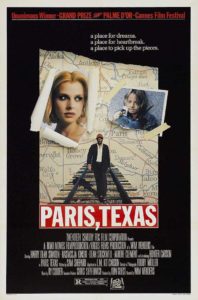WIM WENDERS’ TRANSFIXING PARIS, TEXAS
by Justin Norris

The great state of Texas is magical. It’s a state where its many diverse qualities converge to form a state undoubtedly unique and, in a way, something more mysterious. North, South, East, and West, the state of Texas offers residents and vagabonds alike a chance to experience something different, to change their whole life even at just the turn towards a direction. Truly, under those radiant night skies of Texas, you can choose to be anyone… or no one.
Travis Henderson (Harry Dean Stanton), the elusive protagonist of German director Wim Wender’s PARIS, TEXAS, chooses to be nothing. Under the bright baby blue skies, in a wide stretching range of flat Texas desert, we find Travis wandering with nothing but the tattered clothes on his back. Thanks to Robby Muller’s impeccable cinematography, PARIS, TEXAS vividly captures a beautiful vast landscape that presents itself to our wandering, sad subject. In desolateness, nay- in undisturbed wilderness, Muller’s vivid imagery offers the faintest glimmer of reason behind Travis’ unknowable journey: is it to get away from whatever his problems are? Or is there something to be found in the picturesque flatlands of a never-ending horizon? In its lengthy 2-½ hour runtime, Wenders and writer Sam Shepard (adapting a novel from Texas resident L.M. Kit Carson) slowly dole out answers regarding Travis’ reasoning as they seem content to just sit along with his journey towards self-recollection and possible retribution. But in those first moments, under the crisp blue sky and among the dusty vistas of that Texas wilderness, Travis walks silently (it takes 26 minutes for Travis to actually speak in the film) and PARIS, TEXAS finds power in the silence, revealing moments of uncertain humanity. Even as he’s reunited with his brother Walt (Dean Stockwell) and his story and speech comes to, Travis and the other inhabitants of Wenders’ film find solace in their own internal silences, where their regrets and anger stew around, forever entwined. Where words fail to accurately convey their sadness and isolation, Wenders’ impeccable visuals speak volumes.
A tale that spans from the southernmost tip of Texas to Los Angeles and back again to the southeast of Texas, Wenders soaks in the settings. Indeed, one couldn’t be blamed for calling PARIS, TEXAS a road movie as our main character drives and walks through the crisp, clear days and dark, neon lit nights of his surroundings. These journeys are mostly silent as Travis deals with his achingly stifled feelings regarding his years ago abandonment of his son (Hunter Carson) and wife (Nastassja Kinski). Like a bag of wandering bones, Dean Stanton in appearance and behavior makes for one of the more visually striking central protagonists in cinematic history as his lengthy, sharp features struggle to contain the feelings of regret and resentment brewing within. A perpetual character actor in his long-lasting career, Dean Stanton effortlessly anchors the film, finding narrative strength in his character’s silence which grants his moments of dialogue to feel like something close to an emotional catharsis. At its core, PARIS, TEXAS is a personal story about a man struggling in vain to piece his shattered life back together, but something magical arises from this story thanks to Wenders’ keen visual sense: it elevates past its fictional character and latches onto the viewer, creating a highly evocative film.
Whether it’s in Muller’s vast, expansive cinematography; a symphony of sights that simmer in those oft underappreciated plains and small towns of Texas or in the mournful strumming of Ry Cooder’s acoustic score, PARIS, TEXAS finds hope and despair in the beauty of the its natural settings. As a Texas resident myself, it’s easy to under appreciate the natural, unique wonders of my home state and furthermore, of its citizens. Indeed, as a temporary resident of the humid, sticky corridors of Southeast Texas where this film centers its emotional finale (primarily set in Houston but also filming in Beaumont-adjacent Port Arthur), Wenders and his crew illustrate the power of film, utilizing the more seedy areas of Southeast Texas to uncover an underseen beauty amid even the grimiest corners of the Lone Star State. But even with all the beauty and love to find in the darkest depths of natural beauty, Travis struggles to latch onto it, whether as some form of self-punishment or simply because he is unable to love. Whatever the case, PARIS, TEXAS concludes on a moment of lovely re-connection, offset by the tragedy of uncertainty.
Among the roads found in the US, but especially those of Texas, the world is truly ahead of you. Under the clear skies and among the wide plains and deep forests or even the barest plots of land, the potential to create yourself or self-destruct is readily available. For many souls like Travis, Texas offers a bastion of opportunity in that wideness, a chance to start over and become something new and hopefully, something much better.
You can read more of Justin Norris’ film reviews on Medium @ justinnorris12.medium.com




